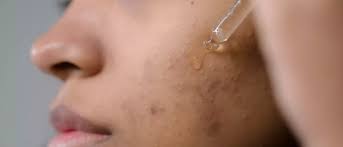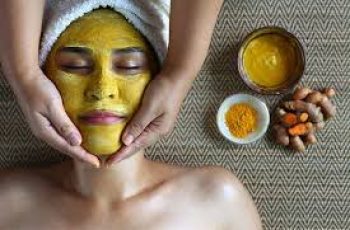How To Treat Post-Inflammatory Hyperpigmentation PIH Skin?
What is Post-Inflammatory Hyperpigmentation (PIH)?
Postinflammatory hyperpigmentation (PIH) of the skin is an increased amount of melanin pigment in the skin (as compared to your normal skin color) that occurs after skin inflammation. It is sometimes called Post Inflammatory Pigment Alteration or PIPA or dermal hypermelanosis. The definition of hyperpigmentation is when you have skin that is darker than your normal skin color. Linea Nigra is a dark vertical line of discoloration from the belly button to the pubic area Hyperpigmentation is more common in darker skin tones such as Fitzpatrick Skin Types 4,5 and 6.
Hyperpigmentation results in an uneven skin tone. There are 8 Baumann Skin Types that have an uneven skin tone and need skin lightening ingredients.
Is Post Inflammatory Hyperpigmentation Permanent?
Does post-inflammatory hyperpigmentation go away? Yes! Although it is not easy to get rid of post-inflammatory hyperpigmentation- it is not permanent. It will eventually fade naturally. Work with your doctor or medical provider to see if post-inflammatory hyperpigmentation treatments like chemical peels are right for you. Combining treatments, a custom skin care routine for your skin type and sun avoidance, your skin will improve.
Don’t lose confidence if it doesn’t clear up after just a few days! Most significant skin care regimens take a few weeks to impart their full effect, so stay consistent!
How long does post-inflammatory hyperpigmentation last?
How long it takes the discoloration to fade depends upon many factors. Fade time is significantly less if you limit sun exposure and use sunscreen diligently. Assuming you have eliminated the cause of inflammation and are using anti-inflammatory ingredients in your skin care routine, and avoiding sun exposure, the uneven skin pigment will most likely last at least 40 days for the skin to clear. This is because of the time it takes for the pigmented skin cells to exfoliate off of the skin and be replaced with skin cells of normal pigment. How to fade hyperpigmentation fast? Follow our dermatologist recommended skin care regimen advice found at this link.
The Best Post Inflammatory Hyperpigmentation Treatment?
Because PIH is very similar to melasma- follow our advice on melasma for the best skin care routine to treat post inflammatory hyperpigmentation. The skin care routine can be combined with chemical peels but make sure you find an experienced medical provider. If they burn you or use the wrong type of chemical peel, this could make the pigmentation worse.
If you have dry, sensitive skin, you are more likely to be suggested a glycolic acid peel than a salicylic acid peel. Glycolic acid leaves oils on the skin while salicylic acid removes oil.
Post inflammatory hyperpigmentation creams
It is important to identify any underlying barriers to skin health and causes of inflammation that may be worsening your skin hyperpigmentation problems. For example, If your PIH is caused by acne, the dark spots from pimples will not get better until your acne is treated. Knowing your Baumann Skin Type® will allow us to customize a skincare routine to treat your hyperpigmentation and any underlying causes.
The best skin lightening products will contain anti-inflammatory and skin lightening ingredients.
Keep in mind that there are different types of skin lightening ingredients like tyrosinase inhibitors, which block the triggers to start melanin production, and even exfoliants that mechanically remove dark spots from the surface of the skin.
The best skin lightening products use a combination of many types of skin lighteners to achieve a more profound effect.
Post inflammatory hyperpigmentation cleansers to clear dark areas of the skin.
There are so many different hyperpigmentation cleansers, so you need to know your Baumann Skin Type to choose the best. Follow the same face wash recommendations that we give for melasma because the issue is the same- too much pigment in the skin.
All cleansers are a little different, so keep in mind when you pick a cleanser for your sensitive skin that you do not choose one that is too low of a pH. products that are too acidic have a chance of irritating sensitive skin.
Look for cleansers rich in soothing linoleic fatty acids for your PIH regimen.
Vitamins, Supplements and Diet to Treat PIH
Treating hyperpigmentation from the inside naturally requires stress reduction, adequate sleep and a well balanced diet because the stress hormone cortisol makes skin pigmentation worse. You can also try antioxidants or these vitamins and supplements to treat PIH from the inside.
Heliocare Supplement Capsule contains polypodium leucotomos, an antioxidant help protect the skin from inflammation due to sun exposure. If you cannot avoid the sun, this skin protective supplement is highly suggested.[[FL-0480-10″>
What Are The Post Inflammatory Hyperpigmentation Causes?
Skin color is caused by many factors, but the amount of a type of melanin known as eumelanin causes most cases of skin hyperpigmentation. A suntan is a form of hyperpigmentation. There are many skin conditions that cause an increase in skin pigmentation. These are common causes of hyperpigmentation and their characteristics:
Causes and other names for PIH
Acne
Melasma (also known as mask of pregnancy)
Skin discoloration on the face
Hyperpigmentation on the cheeks
Hyperpigmentation on the upper lip
Common in pregnancy
Seen with estrogen, hormone replacement therapy and oral contraceptives
Hyperpigmentation in pregnancy
Hormone changes in pregnancy cause skin darkening
Inflammation activates melanocyte cells, causing hyperpigmentation
Common in eczema, psoriasis, hypersensitive skin, allergic reactions, sensitive skin
Phytophotodermatitis
Skin darkening after sun exposure in areas that have been in contact with a photosensitizer that makes skin more reactive to the sun
Causes by celery, limes and figs
Dark spots on skin after drinking margaritas, tequila shots or beer with lime on the beach
Dark spots on the skin after drinking Bloody Mary drinks with celery in the sun
Sun spots
Also called solar lentigos
Click here for what causes sunspots
Click here for how to treat hyperpigmentation caused by the sun
Acanthosis Nigricans
Thick velvet appearing dark patches in skin folds
Dark patch on neck
Dark patches under the arms
Can be associated with diabetes
Ochronosis
Black patches on the face
Caused by an enzyme deficiency or overuse of hydroquinone
Addison’s disease
Caused by an increase in adrenocorticotropic hormone
DQH Knowledge drop: In your 20s, your skin cell turnover decreases. (Cell turnover is a key component in keeping your skin youthful.) You know what else slows down? Your collagen production. Starting in your 20s, collagen decreases by about 1 percent per year. Should you want to prevent fine lines and wrinkles, start by eliminating behaviors that contribute to premature aging. “If it’s bad for you, it’s bad for your skin,” says dermatologist Michel Somenek.
“Cigarette smoking reduces blood flow to the skin and causes premature wrinkling and a dull skin texture. Making the repeated pursed motion to inhale can also cause smoker’s lines. Alcohol and recreational drugs are toxins for the skin that damage its cellular structure and DNA,” Somenek tells us. “The faster you eliminate vices while you are young, the better chance your skin and body have to recuperate.” Also, adopting an anti-aging routine in your 20s is key. After all, the best offense is a good defense. We spoke to Somenek and experts Joshua Ross and Audrey Kunin to find out more.
Keep reading for the best anti-aging products for your 20s, according to skincare professionals.
Sunscreen
“We all know that the sun is the number one cause of skin aging and starting the prevention in your 20s is very important,” Ross says. “The majority of your sun damage won’t start to appear until you’re in your 30s, so don’t wait until you see it surface or you’ll be behind the curve. Stay ahead of it with a good-quality zinc-based sunscreen worn daily.”
Farmacy Green Defense Daily Mineral Sunscreen
An invisible sunscreen with SPF 30, plus botanical extracts meant to protect skin with tons of antioxidants. Bonus: It’s clean and fine to use under makeup.
Bareminerals Complexion Rescue™ Tinted Moisturizer Broad Spectrum SPF 30
Although we recommend you use your SPF and moisturizer separately, we also understand moments when you don’t have time or energy for that extra step. For those times, this bareMinerals moisturizer is a great thing to have on hand.
Vitamin C Serum
“A great introduction to anti-aging is to start with a vitamin C serum in your morning skincare routine,” Ross says. “It’s a powerful antioxidant that will neutralize free radicals and brighten the skin.” He adds that it’s a great way to counteract the effects of the sun’s harmful rays, which, as previously mentioned, are among the biggest causes of premature aging.
Drunk Elephant C-Firma™ Vitamin C Day Serum
The Drunk Elephant C-Firma is a lightweight serum that promises to give skin a glow by combining the brightening powers of vitamin C with ferulic acid, l-ascorbic acid, and vitamin E. The included sodium hyaluronate is meant to replace hydration loss, so you shouldn’t have to deal with any irritation.
Sunday Riley C.E.O. Rapid Flash Brightening Serum
This potent serum is jam-packed with vitamin C (15 percent, to be exact), which means it’s a potential superstar at both brightening skin and dousing it in antioxidants.
Peptides
Using peptides on your skin has many benefits, says Somenek. “The skin barrier is what defends the body against pollution, UV rays, bacteria, and toxins. It can be damaged by several everyday factors. Using topical peptides aids in building a stronger barrier,” he says. “Peptides comprise elastic fibers, which are a type of protein. These fibers help to make skin appear taut and firm. Peptides can also help repair damaged skin, relieve inflammation, and even out skin tone. Some peptides can kill acne-causing bacteria that is common in 20-somethings.”
Kunin agrees, saying, “Peptides are an excellent entry point for supporting collagen.” She recommends looking for face and eye treatments that contain these collagen-boosting powerhouses.
Charlotte Tilbury Magic Eye Rescue Cream
This Charlotte Tilbury super-emollient eye cream has a base of coconut oil and shea butter (read: it’s incredibly hydrating). Botanicals plus peptides are meant to help reduce dark circles and boost collagen, respectively.
This creamy moisturizer serves up potent collagen-boosting peptides and pycnogenol, and antioxidant-rich vitamin C. “Instead of sitting on top of the skin, peptides penetrate the outer layer so they go deep. The ‘signals’ they send tell the cells to produce elastin and collagen, which are needed for youthful-looking skin,” explains Somenek.
At-Home Peel Pads
Remember that skin cell turnover fiasco we talked about earlier? One way to help support it is by exfoliating. “Exfoliation is important to help keep skin fresh and luminous,” Kunin says. She recommends using at-home peel pads as an easy and effective way to exfoliate.
“The goal in your 20s is to fight the slowing pace of cell turnover. It is wise to use products that gently exfoliate, yet still remove oil and other impurities. Products that have Alpha Hydroxy Acids (AHA) or Beta Hydroxy Acids (BHA) are a good choice.”
According to Somenek, you should only exfoliate two to three times a week. “People of all ages are guilty of over-exfoliating and that can be too much of a good thing,” he says.
Dermadoctor Kakadu C Intensive Vitamin C Peel Pad
A few swipes of this Derma Doctor powerful peel pad promise to leave your skin glowing and smooth, thanks to the seven (yes, seven) types of chemical exfoliants, including AHA and BHA. It also contains vitamin C via Kakadu plum extract for added brightening and antioxidant protection.
KEY INGREDIENTS Kakadu plum extract is sourced from the Kakadu plum, a fruit grown in northern Australia. It contains vitamin C, which restores the skin’s natural barrier, increases collagen production, and soothes irritation.
Dr. Dennis Gross Skincare Alpha Beta® Universal Daily Peel Pads
These are the gold standard of peel pads, with a cult following and over 900 five-star reviews on Sephora. They’re easy to use and contain a blend of anti-aging exfoliating acids.
Emollient Night Cream
“In your 20s, you need to start upping the hydration in your skincare routine. You may have been cautious of over-moisturizing because of acne in your teens, but as you enter your 20s, your skin transitions and becomes drier,” Ross says. “I recommend an emollient night cream added into your evening skincare regimen.”
“Twenty-somethings need to make sure that they are not using creams that will clog their pores and cause excess oil production,” says Somenek. Opt for non-comedogenic products.
Cerave Skin Renewing Night Cream
One great choice is the CeraVe Skin Renewing Night Cream, which is a non-comedogenic night cream that leaves skin soft and glowy. It combines the moisturizing powers of ceramides and hyaluronic acid.
RoC Retinol Correxion Max Hydration Creme
“The best night cream ingredients contain retinol, benzoyl peroxide, and/or salicylic acid or hyaluronic acid. The goal is to moisturize, yet remove excess oil,” says Somenek. This Roc Retinol Correxion cream fits the bill as it contains both hyaluronic acid and retinol so it promises to moisturize while also being non-comedogenic.



